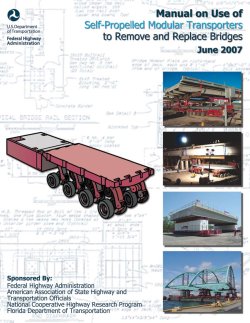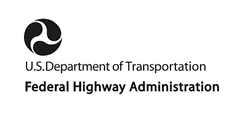Manual on Use of Self-Propelled Modular Transporters to Remove and Replace Bridges

- Executive Summary
- Chapter 1. Introduction
- Chapter 2. Benefits and Costs
- Chapter 3. Planning
- Chapter 4. Design
- 4.1. Design Assumptions
- 4.2. Ground Bearing Capacity
- 4.3. Temporary Shoring Bents at Staging Area
- 4.4. Prefabricated Superstructures
- 4.5. Substructures
- 4.6. Allowable Temporary Stresses and Deflections
- 4.7. Wind Loading
- 4.8. Single-Span Versus Multispan Movements
- 4.9. Possible Design Efficiencies
- 4.9.2. Bridge Reuse Concepts
- 4.9.3. Other Efficiencies
- Chapter 5. Contracting Issues
- Chapter 6. Contract Documents
- 6.1. SPMT Equipment Requirements
- 6.2. Alternative Bridge Span Installation With SPMTs
- 6.3. Alternative Superstructure Design to Reduce Dead Load
- 6.4. Contracting Strategies Using Innovative Contracting Methods
- 6.5. Value Engineering
- 6.6. Partnering
- 6.7. Traffic Control Plans
- 6.8. Prefabrication Plan
- 6.9. Movement Plan, Including Incremental Jacking
- 6.10 Contractor Personnel Plan
- 6.11 Submittal Requirements
- Chapter 7. Case Studies
- 7.1. U.S. Bridge Moves with SPMTs
- 7.1.1. I-4/Graves Avenue, FDOT
- 7.1.1.1. Project Description
- 7.1.1.2. Bridge Removal with SPMTs
- 7.1.1.3. Bridge Construction and Erection with SPMTs
- 7.1.1.4. Time Savings
- 7.1.1.5. Initial Construction Costs
- 7.1.1.6. Delay-Related User Cost Savings
- 7.1.1.7. Net Cost Savings From Use of New Technology
- 7.1.1.8. Participants
- 7.1.1.9. Post-Installation Interviews with Contractor and Bridge Subcontractor
- 7.1.1.10 Lessons Learned
- 7.1.2. I-10/LA 35, LaDOTD
- 7.1.3. Providence River Bridge, RIDOT
- 7.1.4. Wells Street Rapid Transit Bridge, City of Chicago
- 7.1.5. Lewis and Clark Highway Bridge Deck Replacement, WSDOT
- 7.1.1. I-4/Graves Avenue, FDOT
- 7.2. European Bridge Moves with SPMTs
- 7.1. U.S. Bridge Moves with SPMTs
- Chapter 8. Conclusions and Recommendations
- References
- Appendix A: Example User Cost Model Spreadsheet
- Appendix B: Example Plan Sheet Details for Cast-in-Place Deck Closure Pour Option to Facilitate Span Fit-Up
- Appendix C: Example Calculations for Comparing Total Bridge Weight and Estimated Cost Premium for Normal-Weight Concrete and Lightweight Concrete Bridge
- Appendix D: Example Specification for SPMT Equipment
- Appendix E: Example Plan Sheet for Contractor Alternatives
- Appendix F: Example Specification for Lightweight Aggregate
- Appendix G: Example Specification for Incentive/Disincentive and Bonus Used in Conjunction with Contractor Alternatives Plan Sheet (Appendix E)
- Appendix H: Example Specifications for Incentive/Disincentive
- Appendix I: Example Specifications for Bonus
- Appendix J: Example Specifications for Lane Rental
- Appendix K: Example Specification for Value Engineering
- Appendix L: Examples of Partnering Provisions
- Appendix M: Example Plan Sheets for Traffic Control Plans
- Appendix N: Example Specification for Settlement Report for Temporary Shoring on Shallow Foundations
- Appendix O: Example Diagrams for Path and Motion
- Figures
- Figure 1: (a) SPMT six-axle unit, 8 ft (2.4 m) wide
- Figure 1: (b) SPMT six-axle unit, 10 ft (3 m) wide
- Figure 1: (c) SPMT units coupled longitudinally and laterally
- Figure 2: (a) Titan Bridge Lift System
- Figure 2: (b) Climbing jack system
- Figure 2: (c) Container support system
- Figure 2: (d) Strand jack system
- Figure 3: Substructure for temporary bridge support for Nootdorp Bridge in the Netherlands
- Figure 4: Relationship between ground pressure and base preparation (courtesy of Sarens Group)
- Figure 5: Composite dead load design concept for improved cross-section efficiency (courtesy of FDOT)
- Figure 6: Bridge span reuse concepts-Interstate highway widening example (courtesy of FDOT)
- Figure 7: Differential settlement of temporary shoring bents (courtesy of FDOT)
- Figure 8: Removal of FDOT I-4 West Graves Avenue bridge
- Figure 9: Installation of FDOT I-4 East Graves Avenue bridge
- Figure 10: Installation of LaDOTD I-10/LA35 bridge
- Figure 11: SPMTs move RIDOT Providence River bridge span onto barges at staging area
- Figure 12: Wells Street bridge installation in Chicago
- Figure 13: WSDOT Lewis and Clark bridge deck replacement
- Figure 14: (a)SPMTs lift two-span bridge crossing Amsterdam's A4/A5 expressway off temporary supports (courtesy of Mammoet)
- Figure 14: (b)SPMTs move bridge crossing Amsterdam's A4/A5 expressway to final location (courtesy of Mammoet)
- Figure 15: SPMTs moved four-span PRA 13 09 railway bridge in France
- Tables

Sponsored by:
- Federal Highway Administration
- American Association of State Highway and Transportation Officials
- National Cooperative Highway Research Program
- Florida Department of Transportation
FHWA-HIF-07-022
Quality assurance statement:
The Federal Highway Administration (FHWA) provides high-quality information to serve Government, industry, and public in a manner that promotes public understanding. Standards and polices are used to ensure and maximize the quality, objectivity, utility, and integrity of its information. FHWA periodically reviews quality issues and adjusts its programs and processes to ensure continuous quality improvement.
Preface
This manual contains information on the equipment, benefits, costs, project selection criteria, planning, design, contracting issues, and example contract documents for using self-propelled modular transporters to move bridges. It also includes case studies and lessons learned from previous projects. The manual is intended for use by bridge owners, construction contractors, suppliers, and other professionals involved in bridge design and construction.
The development of this manual was sponsored by the Federal Highway Administration (FHWA), the American Association of State Highway and Transportation Officials (AASHTO), the National Cooperative Highway Research Program (NCHRP), and the Florida Department of Transportation. The manual was requested as part of the Scan Technology Implementation Plan following the 2004 FHWA/AASHTO/NCHRP International Scan on Prefabricated Bridge Elements and Systems.
Executive Summary
The use of self-propelled modular transporters (SPMTs) for bridge moves was the top implementation recommendation of the 2004 Prefabricated Bridge Elements and Systems International Scan sponsored by the Federal Highway Administration (FHWA), the American Association of State Highway and Transportation Officials (AASHTO), and the Transportation Research Board's National Cooperative Highway Research Program (NCHRP).
The purpose of the scan was to learn how other countries use prefabricated bridge components to minimize traffic disruption, improve work zone safety, reduce environmental impact, improve constructability, enhance quality, and lower life-cycle costs. The scan team learned that European countries frequently use SPMTs to lift and drive bridges to their final location in just minutes.
SPMTs are computer-controlled platform vehicles that can move bridge systems weighing up to several thousand tons with precision to within a fraction of an inch. The prefabrication of bridges offsite under controlled conditions followed by rapid installation onsite can achieve quality installations with traffic impacts of minutes to a few hours compared to the months typically required for conventional onsite bridge construction.
The significantly reduced onsite construction time when using SPMTs to move prefabricated bridge superstructures, for example, is due to the collapse of the sequential processes of conventional onsite bridge construction to just one step: moving the prefabricated superstructure from the staging area to its final position. This technology should be considered for all bridge replacement projects where reduced onsite construction time is a priority.
The manual provides details from project conception to completion for using SPMTs to remove or install a bridge. It describes equipment, lists benefits and costs, and identifies criteria to determine when this technology is appropriate. It also addresses planning-related issues such as traffic considerations and site requirements. Design issues discussed include temporary shoring and prefabrication requirements, allowable temporary stresses and deflections during the move, and possible design efficiencies because of offsite prefabrication.
Contracting issues covered include staging area requirements and contracting strategies for reduced onsite construction time. Also included are various example calculations, diagrams, plan sheets, and specifications for use as a starting point for upcoming projects using SPMTs to remove or install bridges. Case studies of bridges moved with SPMTs are also included; the 2006 Florida Department of Transportation I-4/Graves Avenue bridge replacement project is covered in detail, and several other projects are summarized.
Using this manual in combination with the FHWA decisionmaking framework and analysis of delay-related user costs should provide the guidance that bridge owners and other bridge professionals need to understand the technology, determine whether using SPMTs will benefit a specific bridge project, and develop contract documents that incorporate the technology.

